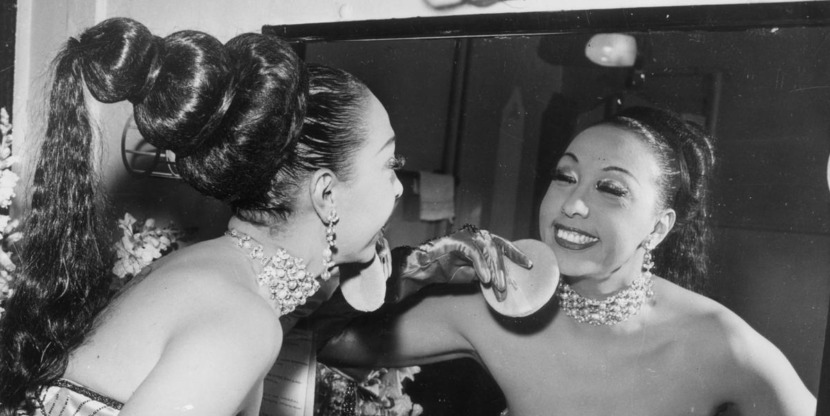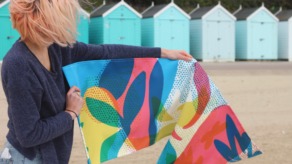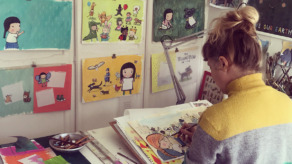Josephine Baker: a life of resistance

‘J’ai deux amours’, sang Josephine Baker. These two loves were Paris, France, where she found freedom and equality, and the US, her homeland. A socially engaged woman, she put her fame to good use.
“When I was a child and they burned me out of my home, I was frightened and I ran away. Eventually I ran far away.It was to a place called France. Many of you have been there, and many have not. But I must tell you, ladies and gentlemen, in that country I never feared. It was like a fairyland place. […] But when I ran away, yes, when I ran away to another country, I didn’t have to do that. I could go into any restaurant I wanted to, and I could drink water anyplace I wanted to and I didn’t have to go to a colored toilet either, and I have to tell you it was nice, and I got used to it, and I liked it. […]
You know, friends, that I do not lie to you when I tell you I have walked into the palaces of kings and queens and into the houses of presidents. And much more. But I could not walk into a hotel in America and get a cup of coffee, and that made me mad.”
Speech
Josephine Baker (1906-1975) gave this speech describing the gap between her two loves, the US and Paris, France, before an audience of 250,000 people. She was wearing her French Resistance uniform with the cross of the Legion of Honor pinned on it, the most important and highest French decoration which she received for the crucial role she played during the Second World War. It was at the March on Washington on August 28, 1963, and she spoke just before Martin Luther King gave his famous ‘I Have a Dream’ oration.
Crossing the Ocean
Josephine was born in Saint Louis, Missouri, US, as Freda Josephine McDonald, on June 3, 1906. This girl of African-American and Native American descent was eight years old when she went into service in a well-off white household. Three years later, riots broke out in Saint Louis and 38 African-Americans were lynched.
Against this violent backdrop, Josephine left Missouri to try her luck in New York City. She was just sixteen and got parts in successful Broadway shows such as Shuffle Along and The Chocolate Dandies. The audience was white, and to please them, clichés were trotted out in the tradition of the so-called ‘blackface minstrelsy’, shows with sketches denigrating black people.
Going to Paris
Josephine could hardly read and write, and had already been married twice when she was asked to join a group of black artists going to perform in Paris, France. At the age of nineteen, she crossed the Atlantic for the first time to perform in La Revue Nègre in the Théâtre des Champs-Élysées. In the midst of the golden age of theater, this performance, which riffs on the myth of the ‘good savage’, was to go down in history as the artistic event of the year.
Josephine performed lively little dances, wearing her now legendary banana skirt. Success gave her wings, and after first joining the famous Parisian theater Folies Bergère as a dancer, she started her own cabaret theater in the Pigalle district, followed by a long and provocative tour through Europe. Back in France, she performed at the Paris casino with a real cheetah by her side. At the same time, she accepted a number of movie roles and can be seen in Zouzou, with the French movie star Jean Gabin, for example.
‘Negro wench’
As a dancer, Josephine quickly became the muse of the greatest artists of her time. Her devilish persona and celebrated hip-wiggling kept her riding the crest of her fame in Paris and Europe for ten years. But then Josephine acquired a different ambition: To conquer a new audience, back in her home country. In 1935, she returned to the US. On Broadway, in New York, she appeared in Ziegfeld Follies at the Winter Garden Theater.
Sadly, the American public was not yet able to accept the success of a dark-skinned artist. Her performance was heavily criticized in The New York Times, which even called her a ‘negro wench’. And on that side of the Atlantic, Josephine was still only allowed to go to her hotel room via the service staircase. She may have been a big artist, but she was still black. She returned to France in a depressed state of mind.
In the Resistance
In 1936, Josephine performed again at the Folies Bergère. She renounced her US citizenship and became a French national after marrying French industrialist Jean Lion; she seemed to have finally made a choice between her two loves—her homeland and Paris. As she returned from a triumphant tour through Europe and South America in 1939, France was declaring war on Germany and her career took a new twist as an agent of the French Resistance.
At the beginning of the Second World War, she met an officer of the French military intelligence, who proposed she become a spy. Prepared to do anything to defend the country that had given her so much, Josephine went to all the official cocktail parties, especially in embassies, to gather information about the enemy forces. When Paris became occupied, she fled to her Château des Milandes in the Dordogne, where she hid countless resistance fighters.
Singing for the troops
Following the call to resistance from French President Charles de Gaulle, on June 18, 1940, Josephine used her tours to recruit secret agents and to pass on information through her musical scores, which she inscribed with invisible ink. But during a stop in Morocco, she became seriously ill and had to be hospitalized for a long time.
Barely recovered, she signed up with the Red Cross and traveled through the desert by jeep to sing for the troops on the frontlines. She even officially joined the French Air Forces in Algeria and became a lieutenant. After the liberation of Paris, she once again performed on the stage at the Théâtre des Champs-Élysées. This time it was for a charity gala, attended by General Charles de Gaulle.
Civil Rights
After the war years, Josephine returned to a more personal struggle. Still determined to conquer the US, she planned a triumphant return to her country of birth. After some extremely tricky negotiations, she succeeded in including a non-discrimination clause in her contract in 1951. Now black people could attend her performances as well as her white audience. In the Copa City Club in Miami, Josephine performed for the first time in front of a mixed crowd, which was a substantial victory.
Josephine’s tour took her through New York, Boston, Chicago and Los Angeles, and she used every stop to stand up for civil rights. And she wasn’t afraid to break the color line as soon as an opportunity presented itself. She sat at a table in the very exclusive Stork Club in New York and placed an order; but she didn’t get served. When she decried this form of discrimination, it led to a protest movement. As a result of this, Josephine was labeled a communist by journalist Walter Winchell, a supporter of Senator McCarthyand his communist witchhunts.
This was a serious allegation that had major consequences and meant that she had to cancel several performances, but it also turned her into an icon of the anti-racism movement. As well as fighting for civil rights in the US, the performer always wanted to defend equality between people. She once said, “Not everyone has the same color, the same language or the same customs, but they have the same heart, the same blood and the same need for love”.
School for Universal Brotherhood
Josephine also dreamed of starting a ‘School for Universal Brotherhood’ dedicated to multicultural studies. Due to the hysterectomy she had to have while in hospital in Morocco during the war, she wasn’t able to have children of her own. She embraced this however by adopting twelve children of different races, nationalities and religions.
In 1947, Josephine married her fourth husband, French orchestra leader Jo Bouillon, and in 1950 she started adopting children from around the world whenever she went on tour, forming a family she often referred to as ‘The Rainbow Tribe’.
She wanted to raise these children—who were born in France, Morocoo, Korea, Japan, Colombia, Finland, Israel, Algeria, Venezuela and the Ivory Coast—with respect for their original cultures and religions. To establish the School for Universal Brotherhood, Josephine undertook renovations in her Château des Milandes, overlooking the Dordogne River. At the entrance there was a sign that read ‘Global Village, the Capital of Universal Fraternity’.
Bankrupt
In the theater on her estate, she hosted the greatest artists of that time (including the singers and actors, Dalida and Jacques Brel) and organized a conference on racism. But the project turned out to be more megalomania than reality, and the renovation of the estate led to bankruptcy. In 1969, she was expelled from her home without seeing her dream of the school come true. She retreated to Monaco with her large family.
At the beginning of April 1975, Josephine starred in a retrospective revue at the Bobino theater in Paris. Her performance was a great success, but it was to be her last: days later, on April 12, she died in her sleep from a brain hemorrhage. It was the end of a life that the artist had lived with dedication, dancing excellence and undiminished fight.
Want to read and see more?
- Josephine: The Hungry Heart, by Jean-Claude Baker and Chris Chase
- Chasing a Rainbow: The Life of Josephine Baker, a documentary by Christopher Ralling
Text Emmanuelle Robin Photography Getty Images







